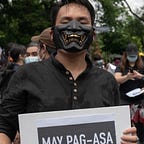In dealing with the Marcos Memory and Martial Law, we must process the collective experiences of those who didn’t suffer and those who didn’t know its atrocities because information was shielded or filtered from them at the time.
For better or worse, we put so much of ourselves into building our nation — including the violence, trauma, and latent authoritarianism in our upbringing. We project our experiences growing up — our memories and visions — onto how a nation’s leaders, workings, and people should be.
A convoluted memory of dictator Marcos remains in the consciousness of so many Filipinos, reinforced by legislation under Duterte (a burial and a day of commemoration).
But memorial politics is not unique to us. Other countries venerate villains too: Columbus in the US, and Tojo, with other Class-A war criminals, at Tokyo’s Yasukuni shrine, for example. The latter even causes periodic political unrest in East Asia.
But to say that the Marcos Memory is merely about personality politics is to fall into the trap of divide et impera. When we lash out at others for being glad about the “Marcos Holiday Bill” or even for being too caring of Duterte, what does it say of us and our understanding of our own people?
To understand the persistent Marcos Memory, we need to go beyond the narratives we’ve grown accustomed to bear and tell. Because the more limited our consciousness is on how and why things are, the more we also tend to be in a constant state of rage. Rage blinds us, confuses us, and limits our expressions and interactions. Rage dislocates and disassociates the activist from the people and communities that need to be engaged.
When we engage others out of anger and rage, we hurt them; we cause pain that reinforces alienation and dehumanization, dividing instead of inviting people to extend themselves and understand — the practice of empathy or pakikipagkapwa.
Pain is shared both by Martial Law victims/survivors and Marcos supporters/sympathizers. For the survivors, pain is about seeing the nation succumb again to the violence, death, and decay of authoritarianism. For the loyalists, pain is about being denied their perceived rights to actualize their ideal nation. When pain is present, we are invited not only to understand pain but also to go to the place of pain and be with those in pain. Even if it means having to sit together in the dark, in silent sorrow, biding for a time of mending and rebirth.
It is necessary then to recognize that the Marcos Memory owes its persistence in popular imagination and opinion to the continued existence of a fractured and fragmented nation, with a people suffering from a “historical” Post-Traumatic Stress Disorder (PTSD). And this, I believe, must lead us to question and dispel the notion of a democratic whole: an assumed national unity, identity, and history in the aftermath of EDSA 1986.
We have to listen intently to those who have been the subject of so much Othering: an estranged people who feel that a national history and a national identity have been imposed upon them after 1986. It is now their revolt that we are experiencing, disguised as Duterte’s regime.
Together with the turncoats at Congress, Marcos supporters/sympathizers are mostly masa, the urban-rural poor, workers, middle-class professionals, OFWs, etc. As Duterte supporters, they publicly challenge, disparage, and revise the post-1986 order towards a charter change-induced Federal government under Duterte or a future Marcos.
The contending popular memories and narratives: People Power the Anti-Authoritarian Movement versus People Power the Anti-Marcos Uprising; the former holds to be the Revolution of a Nation, the latter merely a Revolt in the National Capital Region. Hence, it can be said that People Power 1986 is a people’s revolution but not a peoples’ revolution.
An important part of national identity and national history is shared experiences and collective suffering. The Marcos Memory is tricky because it pits against each other the different memories and lived experiences of people from varied places and social classes during Martial Law. However, this much is clear: the EDSA-born republic has been tried and found wanting.
In dealing with the Marcos Memory and Martial Law, we must process the collective experiences of those who didn’t suffer and those who didn’t know its atrocities because information was shielded or filtered from them at the time. Actual experiences often trump facts. And when we deal with Duterte’s regime, we must integrate the shared frustrations and gambit of the socially, economically, and politically marginalized and disillusioned.
Therefore, to accuse all Marcos and Duterte supporters as fools, historical amnesiacs, fact-deniers, and bobotantes is not only careless, but also insensitive and ill-informed. Doing so alienates and embitters our own people by invalidating their real pain and frustrations, their actual memories, lived experiences, and visions for the nation.
The solution to the national PTSD brought about by Martial Law and EDSA 1986 should have been vigorous institutionalized education on Martial Law, human rights, and democratic governance through the public school system, but there was none.
Hence, let us treat our people’s fatal attraction to the Marcos Memory and to authoritarian figures like Duterte as an invitation to understand better what goes on in the minds and hearts of our people. And as we understand, may we become better at exposing the poisoned whispers and unraveling the threads of twisted tales made at the expense of human lives and human rights.
